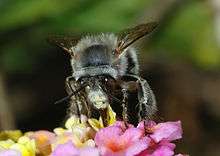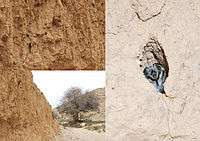Anthophora
| Anthophora | |
|---|---|
 | |
| Anthophora sp. | |
| Scientific classification | |
| Kingdom: | Animalia |
| Phylum: | Arthropoda |
| Class: | Insecta |
| Order: | Hymenoptera |
| Superfamily: | Apoidea |
| Family: | Apidae |
| Subfamily: | Apinae |
| Genus: | Anthophora Latreille, 1803 |
| Subgenera | |
|
see text | |

Gregarious nesting site of Anthophora senescens in a vertical clay cliff of a seasonal water course, Wadi Elot, Israel. Each burrow is an independent nest of one solitary female. On the right hand side, a female guards at the nest entrance.
The bee genus Anthophora is one of the largest in the family Apidae, with over 450 species worldwide in 14 different subgenera. They are most abundant and diverse in the Holarctic and African biogeographic regions. All species are solitary, though many nest in large aggregations. Nearly all species make nests in the soil, either in banks or in flat ground; the larvae develop in cells with waterproof linings and do not spin cocoons. Males commonly have pale white or yellow facial markings, and/or peculiarly modified leg armature and hairs. Anthophora individuals can be distinguished from the very similar genus Amegilla by the possession of an arolium between the tarsal claws.
Species include:
- Anthophora curta
- Anthophora dispar
- Anthophora edwardsii
- Anthophora urbana
- Anthophora furcata
- Anthophora plumipes
References
- C. D. Michener (2000) The Bees of the World, Johns Hopkins University Press.
External links
- Anthophora Identification Guide
- List of Species
- Worldwide Species Map
- Anthophora abrupta Say on the UF / IFAS Featured Creatures Web site
| Wikimedia Commons has media related to Anthophora. |
This article is issued from Wikipedia - version of the Wednesday, September 16, 2015. The text is available under the Creative Commons Attribution/Share Alike but additional terms may apply for the media files.